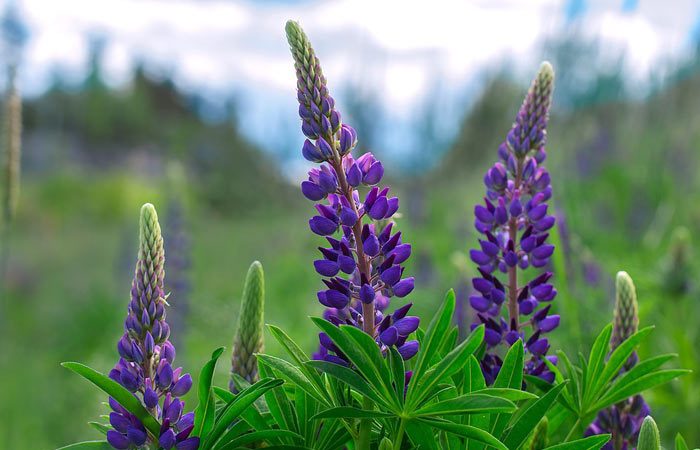
From the Latin lupus, a wolf (destroyer), because it was thought that the plants depleted the fertility of the soil by sheer numbers (Leguminosae). Lupine. A genus of over 300 species of annuals, perennials, and subshrubs, mainly from North America, though there are a few Mediterranean species which, since Roman times, have been used for green manuring. This is surprising since the Roman farmers did not know that within the root nodules were colonies of bacteria capable of utilizing nitrogen to produce valuable nitrates. The fine Russell hybrid lupines are among the showiest of herbaceous perennials and have a wide color range embracing the three primary colors: red, yellow and blue. They do not, however, thrive on alkaline (chalky or limy) soils.
Perennial species cultivated
L. nootkatensis, 1 foot, blue, purple and yellow, May-July, north-west America.
L. polyphyllus, 4 feet, blue, white or pink, June-August, California. Shrubby:
L. arboreus, 6 feet, short-lived, yellow, white or violet, fragrant, summer, California.
L. excubicus, 1-5 feet, blue, violet, summer, California; var. hallii (syn. L. paynei), larger flowers.
Russell hybrids
These well-loved hybrids have developed from a cross made at the end of the last century between L. arboreus and L. polyphyllus. Some years later a seedling with rose-pink flowers appeared, L. p. roseus, and with the help of this, Mr George Russell was able to develop and select the superb colors and strong spikes that are available today in the now famous Russell strain.
Some good cultivars are:
‘Betty Astell’, 3 feet, deep pink; ‘Blue Jacket’, 3 feet, deep blue and white;
`Fireglow’, 3 feet, orange and gold;
‘George Russell’, 4 feet, pink and cream;
‘Gladys Cooper’, 4-5 feet, smoky blue;
‘Joan of York‘, 4 feet, cerise and pink;
‘Josephine’, 4 feet, slate blue and yellow;
‘Lady Diana Abdy’, 3 feet, blue and white;
‘Lady Fayne’, 3 feet, coral and rose;
‘Lilac Time’, 3 feet, rosy-lilac;
‘Mrs Micklethwaite’, 3 feet, salmon-pink and gold;
‘Mrs Noel Terry‘, 3 feet, pink and cream;
‘Thundercloud‘, 3 feet, blue and rose-mauve.
Cultivation
The most popular section is that of the perennial species, which are easily grown in any sunny border that has not too much lime or chalk. Mulch with compost in spring and cut down the old flower stems in October.
The Russell lupines are now available from seed, though the named forms are still raised from cuttings of young growths in March. These are not among the longest-lived plants and it is wise to renew them from time to time. Since they may be raised from seed sown in drills inch deep in April and put in their final places in the autumn. Many will flower during the following summer.
The tree lupine, L. arboreus, may be raised from seed with extreme ease. These shrubs make rapid growth, and will flower in their second season. They are, however, not long-lived, but generally manage to renew themselves by self-sown seedlings. The shrubby lupine, L. excubicus, makes a fine large plant, but needs some frost protection. Like most lupines, this has very fragrant flowers
How to Grow Lupines
Lupinus (lu-py-nus)

